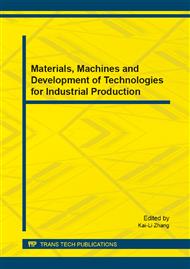[1]
G.D. Hill, Leucaena Leucocephala for pastures in the tropics, Herb. Abst. 41 (1971) 111-119.
Google Scholar
[2]
H.K. Gupta, P.P. Atreja, Influence of feeding increasing levels of leucaena leaf meal on the performance of milk goats and metabolism of mimosine and 3-hydroxy-4 (1H) pyridine, Anim. Feed Sci. Techn. 78 (1999) 159-167.
DOI: 10.1016/s0377-8401(98)00263-6
Google Scholar
[3]
B. Khamseekhiew, J.B. Liang, C.C. Wong, Z.A. Jalan, Ruminal and intestinal digestibility of some tropical legume forages, Asian-Aust. J. Anim. Sci. 14 (2001) 321-325.
DOI: 10.5713/ajas.2001.321
Google Scholar
[4]
A. Wanna, C.I. Boonlom, P. Somkid, C.I. Boonserm, Beta-carotene, mimosine and quality of leucaena silage kept at different duration. Kasetsart J. (Nat. Sci. ), 41(2007) 282-287.
Google Scholar
[5]
R.J. Jones, The value of Leucaena Leucocephala as a feed for ruminants in the tropics, World Anim. Rev. 31 (1979) 13-23.
Google Scholar
[6]
A. Woodward, J.D. Reed, H. Soller, Fodder tree and straw diets for sheep: intake, growth, digestibility and the effects of phenolics on nitrogen utilization, Anim. Feed Sci. Techn. 30 (1990) 39-50.
DOI: 10.1016/0377-8401(90)90050-i
Google Scholar
[7]
X. L . Chen, C.X. Hong, Method study of reduce the mimosa of L. leucaena, Chn. J. Trop. Agric. 2 (1986) 73-75.
Google Scholar
[8]
Y.H. Lin, T.C. Huang, C. Huang, Detoxification of leucaena leaves as feed by ensilage, Botan. Bull. Acad. Sin. 26 (1985) 67-81.
Google Scholar
[9]
J.D. Reed, Nutritional toxicology of tannins and related polyphenols in forage legumes, J. Anim. Scie. 73 (1995) 1516-1528.
DOI: 10.2527/1995.7351516x
Google Scholar
[10]
D.G. Cummins, Relationship between tannin content and forage digestibility in sorghum, Agron. J. 63 (1971) 500-502.
DOI: 10.2134/agronj1971.00021962006300030046x
Google Scholar
[11]
M.A. Osman, Changes in sorghum enzyme inhibitors, phytic acid, tannis and in vitro protein digestibility occurring during Khamir (local bread) fermentation. Food Chem. 88 (2004) 129-134.
DOI: 10.1016/j.foodchem.2003.12.038
Google Scholar
[12]
AOAC., Official methods of analysis, 15th ed., Association of Official Analytical Chemistry, Arlington, (1990).
Google Scholar
[13]
P.J. Van Soest, J.B. Robertsom, B.A. Lewis, Methods for dietary fiber, neutral detergent fiber and non-starch polysaccharides in relation to animal nutrition, J. Dairy Sci. 74 (1991) 3583-3597.
DOI: 10.3168/jds.s0022-0302(91)78551-2
Google Scholar
[14]
R.P. Murphy, A method for the extraction of plant samples and the determination of total soluble carbohydrates, J. Sci. Food Agric. 9 (1958) 714-717.
DOI: 10.1002/jsfa.2740091104
Google Scholar
[15]
X.L. Chen, J.Y. Chen, L.E. Hong, Element of the technology of mimosine of Leucaena leucocephala determination, Chn. J. Trop. Agric. 1 (1985) 52-54.
Google Scholar
[16]
B.Y. Chang, Feed quality and safety testing technology, Chemical Industry Publications, Beijing, (2008).
Google Scholar
[17]
M.P. Hegarty, R.D. Court, Thorne, P.M., The determination of mimosine and 3, 4-dihydroxypyridine in biological material, Aust. J. Agric. Res. 15 (1964) 165-179.
DOI: 10.1071/ar9640168
Google Scholar
[18]
I.E.A. Rahman, M.A.W. Osman, Effect of sorghum type (Sorghum bicolor) and traditional fermentation on tannins and phytic acid contents and trypsin inhibitor activity, J. Food Agric. Envir. 9 (2011) 163-166.
Google Scholar
[19]
C.H. Luo, N.F. Fu, Z. Dan, K. Zhao, B.L. Lei, S.J. Jiang, Study on detoxification of the effective microbiological to the Leucaena leucocephala. Feed Indust. Mag. 30 (2009) 39-43.
Google Scholar


